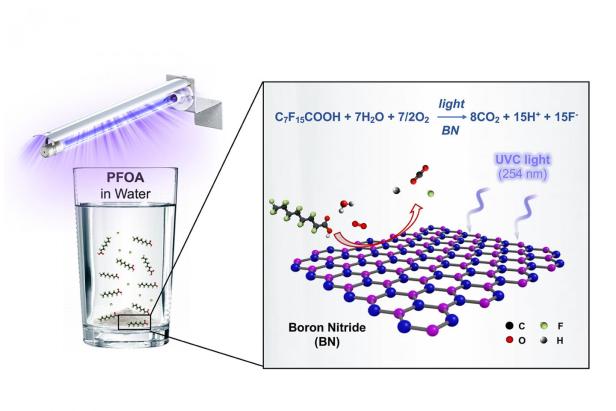Boron nitride destroys PFAS ‘forever’ chemicals PFOA, GenX
By Rice University | EurekAlert | July 7, 2020

Read the full article by Rice University (EurekAlert!)
“HOUSTON — (July 7, 2020) — Rice University chemical engineers found an efficient catalyst for destroying PFAS ‘forever’ chemicals where they least expected.
‘It was the control,’ said Rice Professor Michael Wong, referring to the part of a scientific experiment where researchers don’t expect surprises. The control group is the yardstick of experimental science, the baseline by which variables are measured.
‘We haven’t yet tested this at a full scale, but in our benchtop tests in the lab, we could get rid of 99% of PFOA in four hours,’ Wong said of boron nitride, the light-activated catalyst he and his students stumbled upon and spent more than a year testing.
Their study, which is available online in the American Chemical Society journal Environmental Science and Technology Letters, found boron nitride destroyed PFOA (perfluorooctanoic acid) at a faster clip than any previously reported photocatalyst. PFOA is one of the most prevalent PFAS (perfluoroalkyl and polyfluoroalkyl substances), a family of more than 4,000 compounds developed in the 20th century to make coatings for waterproof clothing, food packaging, nonstick pans and countless other uses. PFAS have been dubbed forever chemicals for their tendency to linger in the environment, and scientists have found them in the blood of virtually all Americans, including newborns.
Catalysts are Wong’s specialty. They are compounds that bring about chemical reactions without taking part or being consumed in those reactions. His lab has created catalysts for destroying a number of pollutants, including TCE and nitrates, and he said he tasked his team with finding new catalysts to address PFAS about 18 months ago.
‘We tried a lot of things,’ said Wong, chair of the Department of Chemical and Biomolecular Engineering in Rice’s Brown School of Engineering. ‘We tried several materials that I thought were going to work. None of them did. This wasn’t supposed to work, and it did.’
The catalyst, boron nitride powder, or BN, is a commercially available synthetic mineral that’s widely used in makeup, skin care products, thermal pastes that cool computer chips and other consumer and industrial products.
The discovery began with dozens of failed experiments on more likely PFAS catalysts. Wong said he asked two members of his lab, visiting graduate student Lijie Duan of China’s Tsinghua University and Rice graduate student Bo Wang, to do final experiments on one set of candidate compounds before moving on to others.
‘There was literature that suggested one of them might be a photocatalyst, meaning it would be activated by light of a particular wavelength,’ Wong said. ‘We don’t use light very often in our group, but I said, ‘Let’s go ahead and doodle around with it.’ The sun is free energy. Let’s see what we can do with light.’
As before, none of the experimental groups performed well, but Duan noticed something unusual with the boron nitride control. She and Wang repeated the experiments numerous times to rule out unexpected errors, problems with sample preparation and other explanations for the strange result. They kept seeing the same thing.
‘Here’s the observation,’ Wong said. ‘You take a flask of water that contains some PFOA, you throw in your BN powder, and you seal it up. That’s it. You don’t need to add any hydrogen or purge it with oxygen. It’s just the air we breathe, the contaminated water and the BN powder. You expose that to ultraviolet light, specifically to UV-C light with a wavelength of 254 nanometers, come back in four hours, and 99% of the PFOA has been transformed into fluoride, carbon dioxide and hydrogen’…”
This content provided by the PFAS Project.
Location:
Topics: